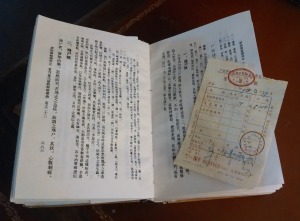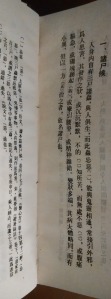How To Embrace Your Inner Undead–And Why It Matters
 When an acupuncturist diagnosed me with “Corpse Disease,” I was ecstatic. Dozens of shape-shifting labels have landed in my chart, but no other theories—not even mine—trace back to medical texts compiled during the Song Dynasty in China.
When an acupuncturist diagnosed me with “Corpse Disease,” I was ecstatic. Dozens of shape-shifting labels have landed in my chart, but no other theories—not even mine—trace back to medical texts compiled during the Song Dynasty in China.
Initially, Dr. Selah Chamberlain, DOM, offered only a few vague comments about three worm spirits inside my body. Due to odd reading habits, I had encountered worm spirits previously. They are not ordinary parasites. They are not even “real” in the Western sense of the word. In Chinese Medicine, worm spirits are forces with the power to impact both internal health and external fate.
But three? In me? Later, I’d learn that every human body—even a healthy one—comes into the world with these three “bugs.” Essentially, Corpse Disease represents the general human condition: the worm spirits are out to get us! The little squigglers “resent the blood and hate capability.”
 One capability I haven’t lost is curiosity. I began plaguing Selah with questions. I trusted him to answer: Selah has practiced acupuncture for more than thirty years on three continents, earned a Masters in Eastern Classics, and translates ancient Chinese medical texts as a “hobby.”
One capability I haven’t lost is curiosity. I began plaguing Selah with questions. I trusted him to answer: Selah has practiced acupuncture for more than thirty years on three continents, earned a Masters in Eastern Classics, and translates ancient Chinese medical texts as a “hobby.”
After a month, and perhaps to shush me, Selah agreed to send his diagnostic source material: a 44-page, single-spaced document with his personal translation of Chapter 56 from the Formulas from the Kindness of the Sage of Great Peace. The text I’d coveted is no film buff’s transcript for the cult classic “Night of the Living Dead.” Chapter 56 does, however, contain the root source of every zombie plotline in history: fear.
 That makes it a 21st century page-turner. I say this despite the contemporary challenges of trying to understand medical theories that were last prevalent during the Sui Dynasty in 610 CE. Thankfully, the formulary is riddled with natural metaphors, aiding interpretation. Disease variants are described as flying, vanishing, hiding, thieving, and gusting. Symptoms leap like cats, become trundling dung beetles, or lie coiled and suddenly strike. Patients can wither lizard-dry or turn green as a toad. The menagerie makes practical sense.
That makes it a 21st century page-turner. I say this despite the contemporary challenges of trying to understand medical theories that were last prevalent during the Sui Dynasty in 610 CE. Thankfully, the formulary is riddled with natural metaphors, aiding interpretation. Disease variants are described as flying, vanishing, hiding, thieving, and gusting. Symptoms leap like cats, become trundling dung beetles, or lie coiled and suddenly strike. Patients can wither lizard-dry or turn green as a toad. The menagerie makes practical sense.
The prescription says to treat the underlying condition and ignore the symptoms. That’s easy for a sage to say! People suffering from corpse disease suffer: stabbing pains, heart palpitations, intestinal trouble, lumps, bumps, wasting, nausea, confusion or delirium, alternating heat and cold, fainting, fatigue, more. And, the definition of fatigue is not as simple as “dead tired.” Even the inability to  stop working is implicated. (Selah recently called me “pathologically helpful.” Yeah, so? He also tells me to stand up straight. Good luck.)
stop working is implicated. (Selah recently called me “pathologically helpful.” Yeah, so? He also tells me to stand up straight. Good luck.)
In Corpse Disease, a person’s Qi—the circulating life force—becomes confused, hyper or depleted, variously unbalanced. Vulnerability inside the body leads to vulnerability outside, or vice versa. The symptoms tend to be highly unstable. During asymptomatic times, the disease merely “hides.”
Portions of my medical history find context here. It’s disconcerting. While Selah identifies clear patterns of Chronic Fatigue Syndrome, I see trauma histories and physical complications from longtime stress. There are enough sub-forms to even ask questions about autoimmune disease, connective tissue disorders, fibromyalgia, Lyme, and more. Some variants are due to inherent sensitivities, others due to poisoning. The worst wipe out entire family lines or villages. A patient can oscillate between being very alive and very nearly dead. Fear can make them want to die.
 The cure requires grappling with the three worm spirits. They reside within the dantien—at the level of the head, heart, and lower abdomen. These are places where breath goes, places we can remember to put our breath, parts of the body we can learn to heed. They are also physical places that correlate to different levels of engagement. Are we attending to the needs up top, the intelligence and spirit? Do we strike balance with the needs of our flesh, the challenges of interpersonal relationships? Can we find a way to remain connected to the earth, to what constitutes nourishment?
The cure requires grappling with the three worm spirits. They reside within the dantien—at the level of the head, heart, and lower abdomen. These are places where breath goes, places we can remember to put our breath, parts of the body we can learn to heed. They are also physical places that correlate to different levels of engagement. Are we attending to the needs up top, the intelligence and spirit? Do we strike balance with the needs of our flesh, the challenges of interpersonal relationships? Can we find a way to remain connected to the earth, to what constitutes nourishment?
While ancient Taoists thought wrangling worm spirits required particular grain-withholding diets, my intuition says modern Americans might do better with a few philosophical shifts:
- Don’t feed your worm spirits other people’s goals and definitions of value.
- Don’t fatten them with guilt, shame, expectations, ambition, or predictions.
- Don’t try to kill them; coexist smartly.
Whether we like it or not, whichever terms we use, whether or not we believe worm spirits exist, we’re stuck with certain truths: as humans we have bodies with sky overhead and earth underfoot. It matters how we negotiate these three realms and our various vulnerabilities.
 In Corpse Disease, recovery—or at least prevention—may be as simple as listening to what the body is saying.
In Corpse Disease, recovery—or at least prevention—may be as simple as listening to what the body is saying.
Or not.
To quote Chapter 56: “At the end of seven days, either there will be improvement, or there won’t.”
What’s funny is how much lighter I felt after receiving official permission to relinquish the idea of living and let myself be undead. For three days after diagnosis, my mood was infected by something akin to bliss. I didn’t feel the need to return phone calls, to get my mail, or fret how I was going to pay the next bill. The concept of obligation was severed at the root.
 And in this liberation, I suddenly found myself free to hear my own desires. What I wanted was whimsy. Specifically, I wanted three-sided whimsy. While ill and unable to walk, I’d pored over satellite maps of the ranch behind my house and spotted an odd triangle made by intersecting cow-paths. What I wanted was to hike the triangle. And I did. Could anything be less relevant? Could anything be more significant?
And in this liberation, I suddenly found myself free to hear my own desires. What I wanted was whimsy. Specifically, I wanted three-sided whimsy. While ill and unable to walk, I’d pored over satellite maps of the ranch behind my house and spotted an odd triangle made by intersecting cow-paths. What I wanted was to hike the triangle. And I did. Could anything be less relevant? Could anything be more significant?
For a few days, I ceased worrying about what I wasn’t achieving while ill. Moreover, I ceased worrying about being ill. I simply stopped. I stopped everything. Disengagement matters.
These days I still get acupuncture weekly and let Selah tend my worm-gnawed innards: it helps. Simultaneously, back in the Land of Western Medicine, I diligently continue to do the body-part-shuffle, a dance familiar to all patients with systemic diseases: from specialist to specialist to specialist, hoping to find a diagnosis this side of the Industrial Revolution. Every day, I also make some time to actively engage in not-fixing anything.
As a poet, I tend to think metaphors can cure everything. As a patient, I’m always skeptical. Nonetheless, Corpse disease might be the most hopeful diagnosis I’ve yet received. A friend teases me, texting, “Does zombie-girl find solace in ancient medical text?”
Yes, I do. It’s logical. Fight, flight, or freeze: “playing dead” is the third basic component of survival. I highly recommend it.
–Lisa Gill
***
Note: Writing, poetry and prose, has a different kind of impact and import when you are chronically ill. It matters down to the bone, but has less to do with public consumption. Nonetheless, I’m going to be doing more medical articles soon, including one on what kind of patient gets ecstatic over a simple corpse reference, and another on passing out at the zendo. all kinds of glory. some will land here, and some I’ll showcase at www.cerebralpeepshow.com …
***
I was first taken to the doctor for an absence seizure at the age of four and have been wrangling various neurological disabilities ever since. Almost three years ago, my latest western diagnosis upended, and I dove into research for simple survival. As things have stabilized, I’ve been enjoying a break from heme synthesis studies and a chance to just get treatments and ask questions. Thanks to Selah for needling, for letting me read his translation, and for humoring me.
Dr. Selah Chamberlain began studying acupuncturewith JR Worsley in England, and continued with TCMand ACTCM in San Francisco, as well as intensivetraining in China at Guangzhou Zhongyi Xueyuan.Tai Ji Quan with Guo Yianling was a formativeinfluence. Selah later took his Masters in EasternClassics from St. John’s. These days, he continues hispractice in Northern New Mexico and at Community Acupuncture Albuquerque, and also serves on the NM


I didn’t realize you were getting treatment from Selah! He is the best source I know of in the state on these early, more spiritually-based forms of Chinese medicine. A few years ago I took his “Demons” class, which focused on issues like corpse disease. Your strategies for dealing with your inner worms seem spot on.